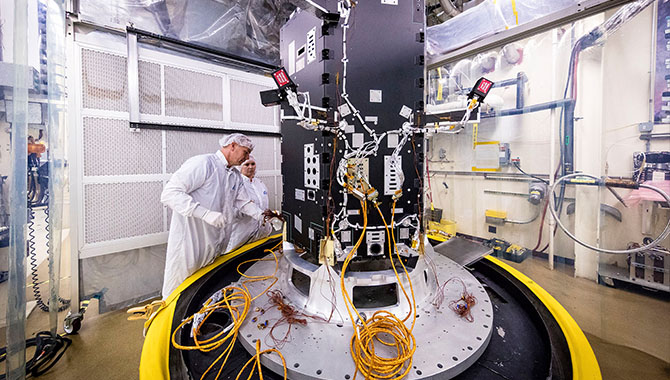
On July 10, NASA’s SOFIA team carefully positioned the aircraft so that it was in the shadow of a star precisely when 2014 MU69 transited in order to learn more about the environment around the Kuiper Belt Object. NASA’s New Horizons mission plans to fly past MU69 on January 1, 2019.
Image Credit: NASA
Thanks to a novel occultation campaign, the New Horizons mission has set its trajectory for the first-ever flyby of a remote Kuiper Belt Object (KBO).
On January 1, 2019, the New Horizons spacecraft intends to fly past 2014 MU69, a small KBO that lies a billion miles farther from the sun than Pluto and more than four billion miles from Earth. At closest approach, New Horizons will be barely more than 2,000 miles from its target: three times closer than it was to Pluto during its historic flyby of that planet.
New Horizons will be traveling at roughly 35,000 miles per hour when zooms past MU69. At that speed, any debris in its path could prove fatal to the spacecraft. For that reason, over the summer of 2017 the New Horizons mission team conducted an occultation campaign: a series of precise ground-based observations of MU69 as it passed in front of a star. During each transit, the particular star’s light dimmed, allowing the team to get a better sense of the shape and size of MU69 as well as to assess the environment around the target KBO, looking for collision hazards such as rings, satellites, or other debris.
To obtain accurate data about MU69 during an occultation, mission scientists—along with their telescopes and other equipment—had to be located in the shadow of the star at the precise moment that MU69 passed in front, dimming its light. Each transit was visible only from specific areas on Earth for a short time: less than three seconds. This meant teams had to be in the right place at the right time with the right equipment—and to hope for clear skies overhead so they could observe the transit. The occultation star calculations were determined in collaboration with ESA’s Gaia satellite team.
The first occultation took place on June 3. Teams spread out across the 400-kilometer area in which the transit would be visible from both north-central Argentina and South Africa. They brought with them dozens of mobile telescopes and crossed their fingers for clear weather.
The second occultation occurred in midair with the help of NASA’s airborne Stratospheric Observatory for Infrared Astronomy (SOFIA) mission. New Horizons team members joined the SOFIA team for a flight from Christchurch, New Zealand over the Pacific Ocean. The goal was to position SOFIA’s enormous 100-inch telescope in the shadow of the star as MU69 transited. They fought unexpected headwinds and swerved to avoid potential areas of turbulence to obtain the needed data.
The final occultation was on July 17, 2017. A team of more than 60 observers with 24 mobile telescopes descended on Patagonia, Argentina to search for and capture data as MU69 passed in front of a star.
Based on findings from the occultation campaign, the team learned much more about MU69 than was known before. Previously seen only by the Hubble Space Telescope, nothing was known about the KBO’s size or shape. Now the team knows MU69 is either a long spherical object roughly 20 miles long or possibly a binary system, in which two objects are orbiting each other. A third possibility is that MU69 is a “contact pair”: two objects touching each other with diameters of 9-12 miles each.
The occultations also provided enough information about the environment surrounding the KBO for the New Horizons team to plot a clear trajectory past MU69 on New Year’s Day 2019. The team put together a back-up plan as well in case they discover unexpected debris as they get closer to their target. While the alternate path won’t take them quite as close to MU69, they will still pass within 6,000 miles, which is closer than New Horizons was to Pluto in 2015.
MU69 was selected for New Horizons’ extended mission because it is a pristine, primordial object with the potential to reveal unprecedented information about the early solar system. It will be the most primitive and distant object a spacecraft has ever explored. During the flyby, New Horizons will use its seven science instruments to investigate the atmosphere around the KBO.
The New Horizons spacecraft, which launched from Cape Canaveral in 2006, is expected to operate until the mid-2030s. The mission is part of the New Frontiers Program, which is managed by Marshall Space Flight Center (MSFC). The Johns Hopkins University Applied Physics Laboratory (APL) designed, built, and operates the spacecraft and manages the mission for NASA’s Science Mission Directorate (SMD). The Southwest Research Institute (SwRI) leads the science mission, payload operations, and encounter science planning.
Read more about the New Horizons extended mission in this APPEL News article.
Read an APPEL News article about the first New Horizons mission: a historic flyby of Pluto.









